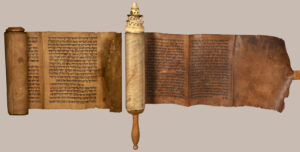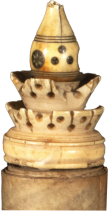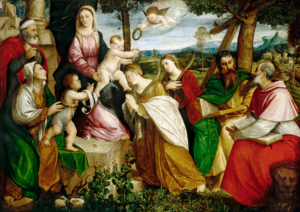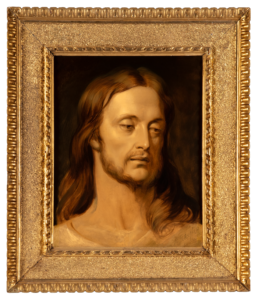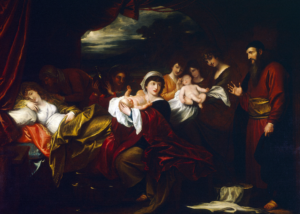This depiction of St. John the Evangelist by the Master of Cueza provides an intriguing look at various accoutrements used by medieval scribes.
Category Archives: Instagram
Hebrew Scroll of the Book of Esther
Gazelle skin and wood
Hebrew Scroll of the Book of Ruth
Parchment on olive wood with ivory crown
The Jewish Bible, known as the Tanakh, is divided into three parts: the Law (Torah), the Prophets, and the Writings. The Writings are also in three divisions: poetry, history, and the Megillot. Synagogue worship during the five annual Jewish holidays often include reading of one of the five, short Megillot scrolls. M&G’s collection of antiquities includes two Megillot scrolls: Esther and Ruth. They are the only biblical books named for females, and both tell dramatic narratives of their heroines.
Esther
Esther, a young Jewish woman, becomes the queen of Persia when King Xerxes (or Ahasuerus) chooses her as his bride. Mordecai, Esther’s cousin and guardian, has offended the king’s chief advisor, Haman, by not bowing to him. This public insult provokes Haman to plot the annihilation of the Jewish people in Persia. When Mordecai learns of Haman’s plan, he urges Esther to use her position to save her people.
Initially Esther is reluctant. By decree, anyone entering the king’s presence without being summoned is to be put to death. Her approaching Xerxes could be fatal. Eventually she is persuaded as Mordecai says: “Who knows but that you have come to the kingdom for such a time as this?” (Esther 4:14).
After three days of prayer and fasting, Esther approaches the King. He extends his golden scepter to her, sparing her life, and tells her that her petition will be granted. She invites the King and Haman to a series of banquets. At the second banquet the king repeats his offer to grant Esther’s petition. She reveals that she is a Jew and tells of Haman’s plan to kill all the Jews in Persia. The enraged king orders Haman’s execution, and it is carried out on the gallows he had prepared for Mordecai. The King then promotes Mordecai to Haman’s position.
The Book of Esther teaches that Divine intervention often occurs in unexpected ways. The story highlights the themes of courage, faith, justice, the reversal of evil, and the importance of standing up for one’s faith in God, even in times of peril.
After Mordecai’s promotion he writes to all the Persian Jews that they should annually “make them days of feasting and joy, and of sending portions one to another, and gifts to the poor” (Esther 9:22). Today the Jewish festival of Purim celebrates this deliverance of the Jews by chanting or reading aloud the Book of Esther as part of synagogue worship. M&G’s Esther scroll is just over 11 ft long, and depending on one’s pace, can take 60–90 minutes to read. During the reading many congregations participate by reciting certain verses and by using wooden noise makers (gragers) to blot out Haman’s name. Purim’s traditional celebratory meal, exchanging gifts of food, and contributions to the poor are based on Mordecai’s instructions.
Ruth
Famine causes Elimelech, his wife Naomi, and their two sons to leave Israel and live among idol-worshipers in the land of Moab. While there, the sons marry Moabite women. Eventually Elimelech and his sons die. Naomi, a grieving and bitter widow, decides to return to Bethlehem and instructs her daughters-in-law to return to their families. One does. Ruth, however, says “Intreat me not to leave thee, or to return from following after thee: for whither thou goest, I will go; and where thou lodgest, I will lodge: thy people shall be my people, and thy God my God” (Ruth 1:16).
In Bethlehem, Ruth gleans in the fields of Boaz, a wealthy relative of Naomi’s late husband. Impressed by Ruth’s kindness to Naomi, Boaz insures she is protected while gathering barley in his fields. Seeing an opportunity, Naomi encourages Ruth to ask Boaz to redeem her, a legal condition that would wed her to Boaz and restore Naomi’s family property. Moved by Ruth’s character, Boaz is inclined to accept but recognizes that a closer relative has the right of redemption. When that kinsman declines to redeem her, Boaz marries Ruth.
The theme of redemption and the virtues of loyalty and faithfulness permeate the Book of Ruth. The universality of God’s providence is also demonstrated. Ruth and Boaz’s son, Obed, is the grandfather of the Jewish King David, which places Ruth, a converted Moabite, in the lineage of the Messiah.
Today many Jewish communities read the Book of Ruth during Shavuot, the two-day holiday that commemorates God giving Moses the Ten Commandments. Shavuot is celebrated during the time of harvest, which parallels the time of Ruth’s gathering barley. Ruth’s acceptance of the Jewish faith parallels the Jewish people accepting the Law delivered to them on Mount Sinai.
M&G’s Megillot Scrolls
To be read in synagogue worship, a scroll must be sefer (ritually clean), meeting a lengthy list of conditions. It must be handwritten by a qualified sofer, using a quill of a kosher bird (or other permitted instrument) with kosher ink, on parchment made of a kosher animal hide. M&G’s Esther scroll, for example, is written on gazelle skin.
Sefer scrolls may not have calligraphic flourishes, illuminations or illustrations. Such additions could distract the reader from thinking about the message of the text. Some Jewish groups, however, permit Megillot scrolls to be embellished. Sefer Esther scrolls have been illuminated with decorative borders and portraits of its characters for centuries. In some Jewish communities a modern scroll of Esther may have colorful, printed scenes of the story between handwritten panels of the Hebrew text. Both M&G’s Esther and Ruth scrolls lack calligraphic or other embellishments. They were probably commissioned for use in strict Jewish congregations.
While groups may differ regarding embellishments of the scroll, its protective coverings (a cloth mantle or a cylindrical box) and the wood dowel on which the scroll is rolled can be ornate. Costly embellishment of the non-textual parts of a scroll reflects a desire to recognize the scroll’s significance and the means of the individual or group commissioning the scroll. M&G’s Ruth scroll is mounted on an olive wood shaft with a carved ivory crown. The scroll is 8.5 ft long and could be read or chanted in about 30 minutes.
William Pinkston, Retired Educator and M&G Volunteer
Published 2025
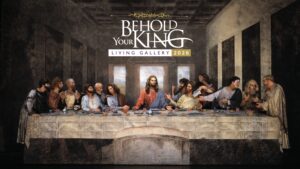
Join Greenville’s leading Easter tradition–attend the annual Living Gallery!
The program varies from year to year. So, come and be challenged and inspired by the drama, uplifting music, and life-size re-creations of great masterpieces (with live models) that make up the Living Gallery, an annual Upstate Easter tradition since 1998.
Behold Your King
What may it cost us to claim Christ as our King? What may we gain if we do? Living Gallery 2026 combines original drama, music, and breathtaking portrayals of classic works of art to celebrate the story of Jesus. The program recreates works such as Max Greiner’s Divine Servant, a Rembrandt etching, M&G’s Christ and the Samaritan Woman by Francois de Troy, and da Vinci’s Last Supper.
Location: Rodeheaver Auditorium, campus of Bob Jones University
Parking: Parking is available on the campus of Bob Jones University.
Performance Times:
Thursday, April 2, 2026 at 4:30 and 7:30PM
Friday, April 3, 2026 at 4:30 and 7:30PM
Saturday, April 4, 2026 at 2:00 and 4:30PM
Living Gallery Tickets:
Adults & Teens: $20 (+fees) and Children (Ages 6-12): $18 (+fees)
- Tickets are on sale at Programs & Productions, in the lobby of Rodeheaver Auditorium, campus of Bob Jones University
- Box Office Hours: Monday-Friday, 12PM to 5PM
- You may purchase tickets HERE.
- Call (864) 770-1372, Monday-Friday, 12PM to 5PM
- Children must be 6 years or older to attend.
- Learn more about the program HERE.
FREE Public Tour: Benjamin West Collection
War Memorial Chapel, campus of Bob Jones University
On Good Friday, April 3 from 3-4PM, join M&G Executive Director, Erin Jones for a guided tour of Benjamin West’s monumental royal painting commission, The Progress of Revealed Religion. The tour is free, open to the public, and will conclude in time for guests to attend the 4:30PM Living Gallery program. There is no need to register.
M&G Scavenger Hunt for Kids (K5-8th grade): The Easter Story in Art
Available February 9–April 14, Monday-Saturday, 10AM-5PM
To celebrate Easter, families are invited to begin at the Welcome Center for a campus search of special art objects related to the Biblical Easter story. This self-guided, informative activity (40-55 minutes long) is designed to captivate your child’s imagination and expose them to the life and times of artisans from the past. Return to the Welcome Center with your finished worksheet for a free prize! This M&G activity is FREE.
Bringing a church group?
Schedule a tour to see selections of M&G’s Collection here.
Want to see works from M&G’s Collection?
See the campus locations displaying selections here.
Wish to enjoy something thoughtful about Easter at home?
View a selection of videos featuring Easter-themed works in the Collection here.
Head of Christ
Oil on panel, signed and dated lower right: A Scheffer 1849
Ary Scheffer
Dutch, active in France, 1795-1858
Ary Scheffer first studied art with his parents, later studying at the Amsterdam Drawing Academy. When his father died, Scheffer moved with his family to study in Paris with the neoclassical painter Pierre Guerin which set Scheffer on the road to Romanticism. A year later, he debuted at the Royal Academy’s Salon Exhibition. Five years after the move, he won his first medal which garnered him patronage by a supporter of the royal family.
The French would call this work an étude—a study made of a model to reference and work out details for a later painting. As such, collectors consider them valuable works. A glance at his oeuvre (body of work) reveals that Scheffer uses this model repeatedly for the Christ figure in several of his works largely during his religious period at the end of his career. Dated 1849, M&G’s study likely influenced later works, such as The Temptation of Christ (1854) in the National Gallery of Victoria and perhaps Christ Weeping over Jerusalem (1849) in the Victoria & Albert Museum (which he repeated in an 1851 version at the Walters Art Museum).
Scheffer’s popularity did extend to England but with a marked division in how the British received his works. The members of the Pre-Raphaelite Brotherhood, just at the start of their own movement (1848), varied in their reactions: William Holman Hunt did not approve, unlike Thomas Woolner. In fact, Hunt convinced D.G. Rossetti that Scheffer’s works were “worthless” (Morris 180).
The Royal Academy in London criticized nearly all the technical aspects of his work, especially his coloring, possibly feeling vulnerable from the acclaim that he was receiving in the industrial North. The growth in the middle class through textile factories in cities such as Manchester and Liverpool made art collecting a mark of affluence and social status. These “barons” were already comfortable with Europe due to product exportation; the importation of ideas from there was a natural consequence. Scheffer was championed by the author Elizabeth Gaskell and collected by the “intensely pious John Heugh” (Morris 186). John Ruskin called him “one of the heads of the mud sentiment school,” but admitted that Scheffer “does draw and feel very beautifully and deeply” (Morris 180).
So if technical excellence was not the draw, what was? Edward Morris states that “it was above all spiritual and emotional exaltation particularly in expression that Scheffer’s English friends admired in his art” (176). This Head of Christ evidences the coloring that drew criticism: the palette is limited to creams and browns with little distinction between Christ’s clothing and His skin. But Christ’s face is what draws attention. Kindness, introspection, firmness of purpose, along with a far-seeing gaze, create the impression that the God-man is on an eternal mission. “Emotional idealism” can easily cross the line into sentimentality, especially in religious works. However, the appeal to sentiment often leads to contemplation, a result that all artists desire. And anything more than a passing glance at Scheffer’s Head of Christ compels the viewer to ponder the Savior of the world.
Dr. Karen Rowe Jones, M&G board member
Work Cited:
Morris, Edward. French Art in Nineteenth-Century Britain. Yale UP, New Haven. 2005
Roughly the same size, these beautifully rendered panels painted by Pietro Negroni most likely came from an altarpiece in a convent church in the Calabrian city of Cosenza.
This vibrant painting depicting Abraham and his family’s departure for Canaan features many of the details that the Bassano family were skilled in painting.
Esau and Jacob Presented to Isaac
Benjamin West, P.R.A.
Below the image, click play to listen.
You can learn more about the entire series by West and M&G’s significant collection from the series HERE.
